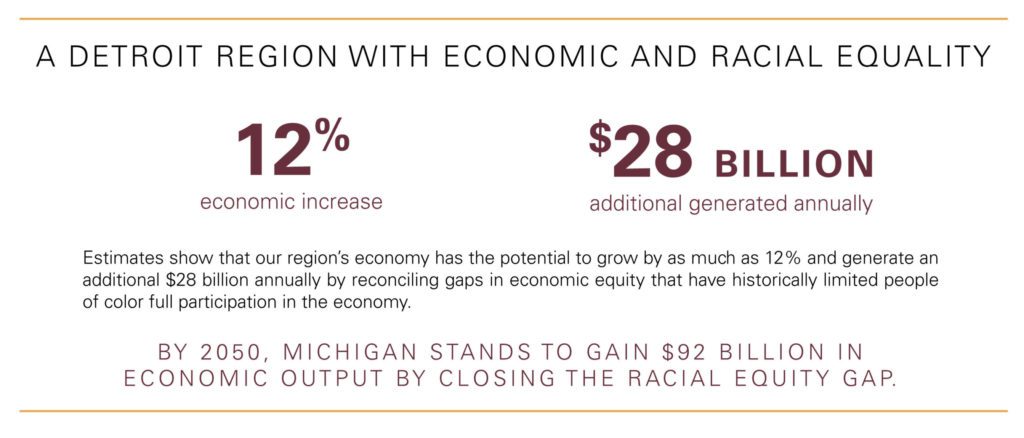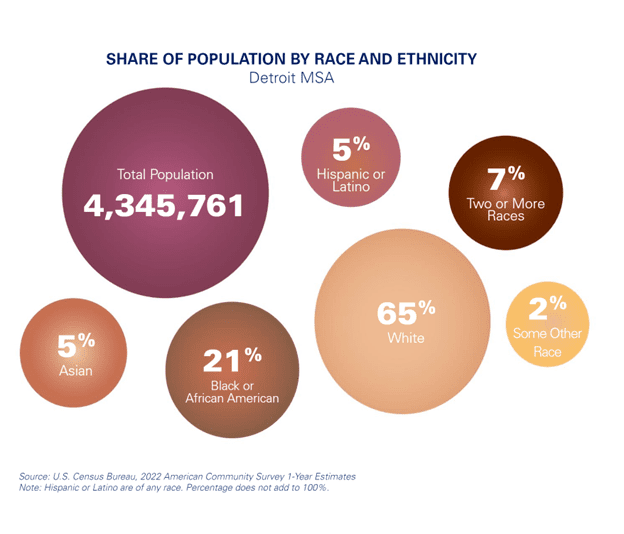The ideal Detroit Region is an equitable and fair community where everyone has the opportunities, resources, and tools to participate and prosper. To build a strong economy and drive economic growth, leaders in the private and public sectors need to advance racial equity. According to PolicyLink, estimates show that the Region’s economy can grow by as much as 12% and generate an additional $28 billion annually by reconciling gaps in economic equity that have historically limited people of color from full participation in the economy. W.K. Kellogg Foundation reports that by 2050, Michigan stands to gain $92 billion in economic output by closing the racial equity gap.

As the conversation continues to move forward, data is key to determining how to close these gaps. The Chamber’s Data and Research team highlights how the Region is doing on key measures of inclusive prosperity.
Share of the Population
- In 2022, the Detroit Region’s population was 65% white residents, with Black or African American residents accounting for 21% and Latino or Hispanic and Asian residents accounting for 5% each.
- The Region has a higher share of Black or African population compared to the national share of 12%.


Expand for Data
- Median Household Income
-
AVERAGE INCOME INCREASED FOR ALL RACES AND ETHNIC GROUPS, BUT INEQUITIES PERSIST IN INCOMES IN THE DETROIT REGION
WHAT IT SHOWS:
- Median household income increased for all races year-over-year. Hispanic or Latino households experienced the largest increase in income at 8.2%, followed by white (6.2%), Black or African American (5.4%), and Asian (1.4%).
- While income increased for all races and ethnic groups, disparities remain stark. The income gap between Asian households and Black households is nearly $70,000, and the income gap between white and Black households is over $37,500.
WHY IT MATTERS:
- An increase in income is instrumental in advancing the financial stability of households and communities. Wealth equity can increase economic growth and upward mobility, resulting in opportunities for better standards of living for all.
- Unemployment Rate
-
BLACK OR AFRICAN AMERICAN POPULATION HAD THE LARGEST DECLINE IN UNEMPLOYMENT RATE YEAR-OVER-YEAR
WHAT IT SHOWS:
- In 2022, the unemployment rate decreased for all racial and ethnic groups. However, The Black or African American unemployment rate decreased by almost five percentage points year-over-year— the largest decline among racial groups.
WHY IT MATTERS:
- Unemployment rate measures the percentage of people over 16 who aren’t working but are available and actively looking for work. Ensuring true full employment would reduce racial inequities and poverty while boosting workers’ bargaining power and creating a stronger economy.
- Labor Force Participation Rate
-
HISPANIC OR LATINO AND ASIAN WORKERS ONLY GROUPS TO INCREASE LABOR FORCE PARTICIPATION YEAR-OVER-YEAR
WHAT IT SHOWS:
- Labor force participation rates were highest among Hispanic or Latino (68.8%) and Asian (67.5%) workers. Hispanic workers (1.2 p.p.) had the largest increase in participation, followed by Asian (1.1 p.p.).
- The participation rate of white and Black or African American workers remained unchanged year over year. Labor force participation rates were lowest among Black or African American workers (59.8%).
WHY IT MATTERS:
- The labor force participation rate measures the percentage of the working-age population that is either employed or actively seeking employment. A high participation rate indicates that a larger proportion of the population is actively contributing to the economy through employment. This can increase productivity, higher consumer spending, and overall economic expansion.
- Poverty Rate
-
BLACK OR AFRICAN AMERICAN RESIDENTS FACE POVERTY AT HIGHER RATES COMPARED TO OTHER RACIAL AND ETHNIC GROUPS
WHAT IT SHOWS:
- In 2022, the Black or African American population experienced the largest increase in poverty (1.6 p.p.). Over 26% of Black individuals are below the poverty line, over 13 percentage points higher than the national rate.
WHY IT MATTERS:
- Poverty is an important indicator of economic well-being. Federal and state policymakers, as well as community stakeholders, often use poverty rates to identify communities in need and estimate the number of families eligible for government programs.
- Black and Hispanic families consistently experience higher levels of poverty, especially when compared with their white counterparts. Ongoing factors like decades of disinvestment in social programs, discriminatory hiring practices, and disparities in generation wealth have also contributed to poverty.
- Educational Attainment
-
STARK DISPARITIES PERSIST IN EDUCATIONAL ATTAINMENT AMONG RACIAL AND ETHNIC GROUPS
WHAT IT SHOWS:
- In 2022, Asian adults in the Detroit Region were most likely to hold a bachelor’s degree or higher among all racial and ethnic groups at 66.2% and outperformed the national average.
- The share of Black or African American adults reflected the lowest educational attainment (19.1%)—far below the Detroit Region’s rate of 34.5%.
WHY IT MATTERS:
- Higher wage jobs require ever-higher levels of skills and education. Closing wide, persistent racial gaps in educational attainment is key to building a strong workforce.
- Chamber programs like the Detroit Promise, which offers tuition-free college access for Detroit high school graduates; Detroit Reconnect, which helps adults pursue higher education; and Detroit Drives Degrees, which works on reaching 60% postsecondary attainment while cutting the equity gap in half.
- Homeownership Rate
-
BLACK OR AFRICAN AMERICAN HOMEOWNERSHIP AMONG THE LOWEST IN THE REGION
WHAT IT SHOWS:
- In 2022, Black or African American households in the Region had the lowest homeownership rate at 46.5%, almost 19 percentage points lower than the national average.
- Hispanic or Latino (-2.0 p.p.) and Asian (-0.3 p.p.) households saw the largest decline in homeownership year-over-year, while Black or African American and white homeownership experienced a slight increase of one-tenth of a percentage point.
WHY IT MATTERS:
- Homeownership can be a critical pathway to economic security and mobility. Income gaps among races, along with discriminatory housing policies such as redlining, have prevented generations of Black or African Americans from purchasing homes and increasing wealth.
- Public Transit Commuters
-
BLACK OR AFRICAN AMERICAN WORKERS ARE MORE LIKELY TO COMMUTE BY TRANSIT AND EXPERIENCE LONGER AVERAGE COMMUTES
WHAT IT SHOWS:
- Black or African American residents account for 68% of the total public transit commuters in the Detroit Region. The average commute time by public transit is 50 minutes, compared to 26 minutes for car commuters.
WHY IT MATTERS:
- Public transit is critical infrastructure for commuters, and many residents rely on these systems to perform essential activities. Long commute times can put workers at a unique disadvantage, affecting job accessibility and attainability. Funding reliable and accessible transit can lead to higher economic prosperity.
Source:
U.S. Census, 2022 American Community Survey 1-Year Estimates

Learn how the Chamber is committed to racial justice and economic equity.













